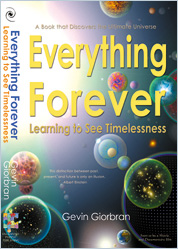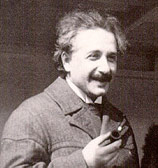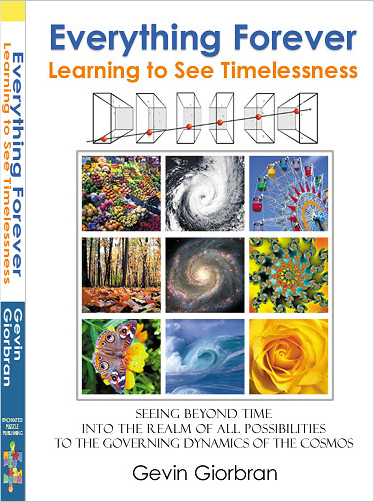| |||||||||||||
“
Time has no independent existence apart from the order of events by which we measure it.”—Albert Einstein
Excerpt from Chapter One
in
The Book:
Everything Forever:
Learning to See Timelessness
“You have the sight now Neo, you are looking at the world without time.”
—The Oracle in The Matrix
“I have realized that the past and future are real illusions, that they exist in the present, which is what there is and all there is.”
—Alan Watts
Albert
Einstein and the Fabric of Time Surprising as it may be to most non-scientists and even to some scientists, Albert Einstein concluded in his later years that the past, present, and future all exist simultaneously. In 1952, in his book Relativity, in discussing Minkowski's Space World interpretation of his theory of relativity, Einstein writes: Since there exists in this four dimensional structure [space-time] no longer any sections which represent "now" objectively, the concepts of happening and becoming are indeed not completely suspended, but yet complicated. It appears therefore more natural to think of physical reality as a four dimensional existence, instead of, as hitherto, the evolution of a three dimensional existence. Einstein's belief in an undivided solid reality was clear to him, so much so that he completely rejected the separation we experience as the moment of now. He believed there is no true division between past and future, there is rather a single existence. His most descriptive testimony to this faith came when his lifelong friend Besso died. Einstein wrote a letter to Besso's family, saying that although Besso had preceded him in death it was of no consequence, "...for us physicists believe the separation between past, present, and future is only an illusion, although a convincing one." Most everyone knows that Einstein proved that time is relative, not absolute as Newton claimed. With the proper technology, such as a very fast spaceship, one person is able to experience several days while another person simultaneously experiences only a few hours or minutes. The same two people can meet up again, one having experienced days or even years while the other has only experienced minutes. The person in the spaceship only needs to travel near to the speed of light. The faster they travel, the slower their time will pass relative to someone planted firmly on the Earth. If they were able to travel at the speed of light, their time would cease completely and they would only exist trapped in timelessness. Einstein could hardly believe there were physicists who didn’t believe in timelessness, and yet the wisdom of Einstein's convictions had very little impact on cosmology or science in general. The majority of physicists have been slow to give up the ordinary assumptions we make about time. The two most highly recognized physicists since Einstein made similar conclusions and even made dramatic advances toward a timeless perspective of the universe, yet they also were unable to change the temporal mentality ingrained in the mainstream of physics and society. Einstein was followed in history by the colorful and brilliant Richard Feynman. Feynman developed the most effective and explanatory interpretation of quantum mechanics that had yet been developed, known today as Sum over Histories. Just as Einstein's own Relativity Theory led Einstein to reject time, Feynman’s Sum over Histories theory led him to describe time simply as a direction in space. Feynman’s theory states that the probability of an event is determined by summing together all the possible histories of that event. For example, for a particle moving from point A to B we imagine the particle traveling every possible path, curved paths, oscillating paths, squiggly paths, even backward in time and forward in time paths. Each path has an amplitude, and when summed the vast majority of all these amplitudes add up to zero, and all that remains is the comparably few histories that abide by the laws and forces of nature. Sum over histories indicates the direction of our ordinary clock time is simply a path in space which is more probable than the more exotic directions time might have taken otherwise. Other worlds are just other directions in space, some less probable, some equally as probable as the one direction we experience. And some times our world represents the unlikely path. Feynman's summing of all possible histories could be described as the first timeless description of a multitude of space-time worlds all existing simultaneously. In a recent paper entitled Cosmology From the Top Down, Professor Stephen Hawking of Cambridge writes; “Some people make a great mystery of the multi universe, or the Many-Worlds interpretation of quantum theory, but to me, these are just different expressions of the Feynman path integral.” (below is not in book) What is still not quite resolved in modern physics is how to properly combine Quantum theory with Einstein's Relativity Theory. It appears evident that time is purely a direction in space but how then do we explain the uncertainty of quantum mechanics? Why does it appear that God plays dice with the world. The two theories, each having been proven by their usefulness, do of course tell the same story about this one universe, but we just haven't learned yet to hear the story right. The best modern theory going is probably the No Boundary Proposal, put fourth by Stephen Hawking and Jim Hartle. This theory introduces a second reference of time which has been inappropriately named Imaginary time. Hawking, writes of the no boundary proposal, "The universe would be completely self contained and not affected by anything outside itself. It would neither be created nor destroyed. It would just BE." In my book Everything Forever, and here at my website, I explain how fourth dimensional spatial directions travel through a series of independent three dimensional block-like spaces, which in science we call states, but they can also be thought of simply as patterns. Hawking has already proposed that imaginary time can be found at right angles to ordinary time. I further explain that it is possible in an objective way to understand the universe to be like a book or a movie film. Each moment is a separate universe just like each frame of a movie or page of a book is separate. Yet those separate states simultaneously form the larger whole of the movie or the book. Seeing each moment as a continually existing place sheds light on why particles would then travel as a quantum wave, rather than linearly from point a to point b. This is explained better elsewhere, but if each moment of ordinary time is a solid, static, "block of now", or field of space, then time each new moment is a distinctly different universe. What we call time is a spatial direction that travels through many static three dimensional universes. In such a model, what we call time is created purely out of space. Special directions in space travel through each static three dimensional space, therein producing a new realm of space beyond three dimensions, which we call time. The interesting quality this produces, is how the inhabitants of this fourth dimension of space travel a linear path from past to future, but the surrounding environment of each path is shifting from one pattern to the next. This sends particles from one position in four dimensional space to the next without moving linearly. As a result, each individual observer in the fourth dimension experiences a continuous linear time, even though everything in their immediate environment is moving sequentially from place to place. Hence each temporal environment of four dimensional space is constructed relative to each independent observer. One can imagine oneself smoothly traveling a direct and interconnected path through time, but in looking around at one's environment, one sees that all other directions of time are broken, causing particles to appear to sequentially leap from one place to another. Paradoxically, everyone observes their own path and experience of time to be linear, while all else around them is sequential. In fact, when we explore time as a direction through many 3D spaces, we find qualities of curvature, time dilation, and spatial contraction, precisely as relativity describes those qualities within our own spacetime. There is one quote I have found from Einstein which is more or less a contemplative mental thought about the notion of infinite spaces, which doesn't directly relate to my own approach of describing a shape to all possible spaces, but it does at least open up the subject of an infinite number of spaces to speculation. And it also shows the open minded nature of Einstein's thoughts about empty space, which some have thought were closed. When a smaller box s is situated, relativity at rest, inside the hollow space of a larger box S, then the hollow space of s is a part of the hollow space of S, and the same "space," which contains both of them, belongs to each of the boxes. When s is in motion with respect to S, however, the concept is less simple. One is then inclined to think that s encloses always the same space, but a variable part of the space S. It then becomes necessary to apportion to each box its particular space, not thought of as bounded, and assume that these two spaces are in motion with respect to each other... Before one has become aware of this complication, space appears as an unbounded medium or container in which material objects swim around. But it must be remembered that there is an infinite number of spaces, which are in motion with respect to each other... The concept of space as something existing objectively and independent of things belongs to pre-scientific thought, but not so the idea of the existence of an infinite number of spaces in motion relatively to each other. This latter idea is indeed unavoidable, but is far from having played a considerable role even in scientific thought. I can testify that Einstein's speculations revealed here concerning infinite spaces in motion do at least carry us in the right direction in how they suggest space might have an unseen and possibly infinite content. Similar ideas were introduced by David Bohm, who claimed there are two kinds of order in nature, what he called explicate order and implicate order. Implicate order for Bohm was a way of acknowledging how quantum mechanics reveals a hidden order where our world is influenced by the whole of all possible states. However, that order is much more visible than Bohm ever realized, as explained in part two. Unfortunately it wasn't until Einstein died that scientists began to consider the a Many Worlds Theory in science. It's safe to say that in Einstein's time we were still getting used to the idea of the Big Bang, adjusting to the ever more visible vast sea of other galaxies, and the possibility of alien life on other planets. The universe and reality were still primarily considered purely solid and material based. Quantum theory, which eventually led to the theory of many worlds, had not yet fully withstood the test of time. Einstein even rejected its implications, saying "God does not play dice" with the world, even as he himself established that there is more to the universe than a single evolving moment of now. In my explorations of timelessness I reveal that ordinary space is not merely full of other empty spaces, but empty space is actually the whole of all physical realities; all the universes of the many worlds theory. Profound as it may be, if the theories I propose are correct, space is full, rather than empty. Material things are less than the fullness of space. In fact, it may be that space must include all possibilities in order to seem empty to us. So in summary, the universe we see is just a fragment nested in a timeless (everything) whole, rather than a single material world magically arisen above some primordial nothing. All universes exist without beginning or end in the ultimate arena of time, and each moment we experience exists forever. Find out more about timelessness at:
Contents Part I The Beginning of Timelessness Ch1
Time is Imaginary Part II The Governing Dynamics Ch6
Natural Order Part III The Comprehensibility Of All Ch10
Infinity Means What? Part IV The Great Cosmic Attractor Ch12
The Shape of All Conceivables Part V The Second Law is Too Simple Ch17
Away from Order toward Order Part VI Cosmic Psyche Ch21
God’s Math Part VII Spiritual Science Ch25
Becoming Aware This page last updated April 10th, 2007. References |
| Your welcome to send an e-mail and share your thoughts when you're done reading. |
|
Homepage | Part One | Part Two | Part Three | Part Four | Contents | Forward | e-mail | |
|
© Gevin Giorbran, Copyright 1996 - 2007 All rights reserved. Privacy Policy | Usage Policy |
|
|




